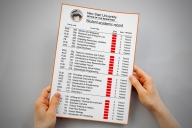You have /5 articles left.
Sign up for a free account or log in.
By now, it is widely accepted that curricular efforts to "engage" students -- to involve them deeply in the process of learning and in the actual material they study -- pays off. But as the number and proportion of underrepresented minority students and academically underprepared students of all races in college grows, educators and policy makers have lacked hard evidence that "engagement" practices work for those students, too.
Two new studies, however, suggest that not only does "engagement" work for minority and academically underprepared students, but such practices make a bigger difference for such students than for students in general.
The studies come from two of the biggest and best-known names in the learning assessment world: George D. Kuh, Chancellor's Professor and director of the Center for Postsecondary Research at Indiana University, and Ernest T. Pascarella, Mary Louise Petersen Chair in Higher Education and co-director of the Center for Research on Undergraduate Education at the University of Iowa. Both measured the effects of participating in certain kinds of educational activities -- collaboration with other students, significant faculty-student contact, etc. -- that are generally thought to "engage" students in the learning process.
The first study, "Connecting the Dots," financed by the Lumina Foundation for Education and Wabash College's Center for Inquiry in the Liberal Arts, examines the performance of about 11,000 freshmen and seniors (not sophomores, as an earlier version of this article suggested) at 18 four-year institutions that have used the National Survey of Student Engagement, which Kuh founded, to measure how engaged their students are in learning.
By matching the colleges' NSSE results against never-before-collected data about the students' academic preparation and demographic results, and against the students' first-year grades and persistence to the second year, the new study offers a look at how academic "engagement" affects different sorts of students. And the study's most significant finding on that score is that "historically underserved students benefit more from engaging in [educationally effective practices] than white students in terms of earning higher grades and persisting to the second year of college."
For example, says Kuh, students who came into college with lower ACT scores (those who scored 20 or under) and participated in "educationally purposeful activities" saw a greater increase in their grade point averages as freshmen than did similarly engaged students with higher ACT scores (28 and above). And as Hispanic students grew more engaged academically, their first-year academic performance grew much more sharply than did that of white students -- so much so that at higher levels of engagement, Hispanic students outperformed their white peers.
Similarly, at the highest levels of academic engagement, African-American students in the study became likelier to return for their sophomore year than were similarly engaged white students.
"The bottom line is that everybody benefits from these activities, but that there are certain activities that are more beneficial for certain groups," says Kuh, whose co-authors on the study were Jillian Kinzie, Ty Cruce, Rick Shoup, and Robert M. Gonyea. "So these activities have what we call "compensatory effects" -- engagement compensates for a lower level" of academic preparation coming in to college.
The other study, which Pascarella co-wrote with Cruce, Gregory C. Wolniak, and Tricia A. Seifert, was done as part of the National Study of Student Learning, financed by the U.S. Education Department. (It is in the current issue of the Journal of College Student Development, but is not available online.) It examined students who entered a representative mix of 18 four-year colleges and five community colleges in 1992, and found that virtually across the board, using a set of "principles for good practices in undergraduate education" has "a significant positive impact on the cognitive development, learning orientations, and educational aspirations of students" in their first year in college.
And like the Kuh study, the Pascarella report found a "compensatory effect" for students who enter college academically underprepared. "Thus, although the focus of attention has typically been on the general impact of good practices for all students, our findings suggest that good practices may be particularly important for those students who enter postsecondary education with the least educational capital," the authors write.









